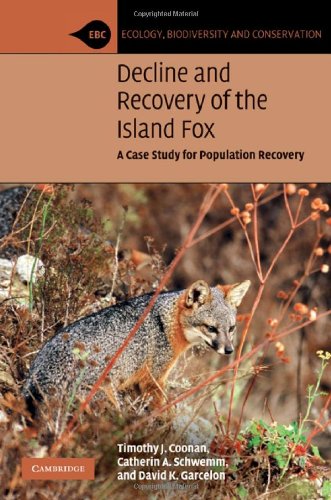VetSam
Member
- Joined
- Feb 24, 2009
- Messages
- 321
- Reaction score
- 20
- Points
- 18
Decline and Recovery of the Island Fox:
A Case Study for Population Recovery (Ecology, Biodiversity and Conservation)
By Timothy J. Coonan, Catherin A. Schwemm, David K. Garcelon

Pages: 232
Publisher: --
Edition: 1st., 2010
Language: English
ISBN-10 / ASIN: 0521715105
ISBN-13 / EAN: 9780521715102
Description
Native only to the California Channel Islands, the island fox is the smallest canid in North America. Populations on four of the islands were threatened to extinction in the 1990s due to human-mediated predation and disease. This is the first account of the natural history and ecology of the island fox, illustrating both the vulnerability of island ecosystems and the efficacy of cooperative conservation measures. It explains in detail the intense conservation actions required to recover fox populations, such as captive breeding and reintroduction, and large-scale ecosystem manipulation. These actions were successful due in large part to extraordinary collaboration among the scientists, managers and public advocates involved in the recovery effort. The book also examines the role of some aspects of island fox biology, characteristic of the 'island syndrome', in facilitating their recovery, including high productivity and an apparent adaptation to periodic genetic bottlenecks
Enjoy! :up:
A Case Study for Population Recovery (Ecology, Biodiversity and Conservation)
By Timothy J. Coonan, Catherin A. Schwemm, David K. Garcelon

Pages: 232
Publisher: --
Edition: 1st., 2010
Language: English
ISBN-10 / ASIN: 0521715105
ISBN-13 / EAN: 9780521715102
Description
Native only to the California Channel Islands, the island fox is the smallest canid in North America. Populations on four of the islands were threatened to extinction in the 1990s due to human-mediated predation and disease. This is the first account of the natural history and ecology of the island fox, illustrating both the vulnerability of island ecosystems and the efficacy of cooperative conservation measures. It explains in detail the intense conservation actions required to recover fox populations, such as captive breeding and reintroduction, and large-scale ecosystem manipulation. These actions were successful due in large part to extraordinary collaboration among the scientists, managers and public advocates involved in the recovery effort. The book also examines the role of some aspects of island fox biology, characteristic of the 'island syndrome', in facilitating their recovery, including high productivity and an apparent adaptation to periodic genetic bottlenecks
Enjoy! :up:
Last edited by a moderator:
